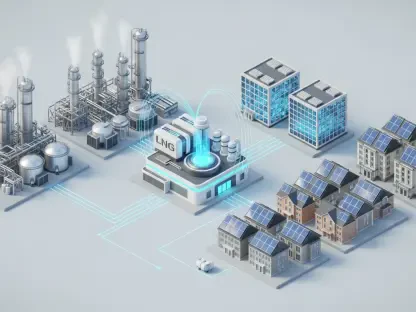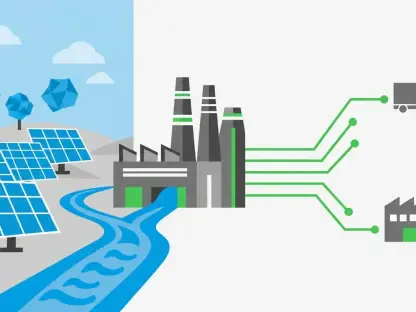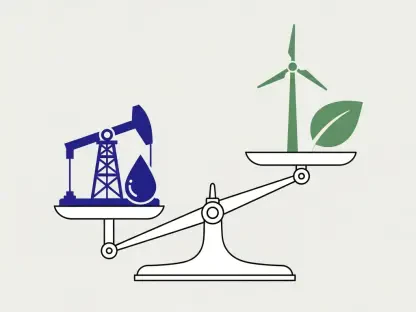The global energy sector is undergoing a seismic shift, with smart grids emerging as the cornerstone of a more sustainable and efficient future. As the world grapples with the urgent need to integrate renewable energy sources, bolster grid resilience, and optimize energy consumption, the demand for advanced power systems has surged to unprecedented levels. A remarkable forecast of $573.7 billion in transmission infrastructure investment by 2030 highlights the enormity of this transformation. This projection reflects not just a financial commitment but a profound reimagining of how energy is generated, distributed, and managed in an era of rapid technological advancement and environmental imperatives. Smart grids, unlike their traditional counterparts, offer the promise of real-time adaptability and efficiency, addressing modern challenges like climate change and rising energy needs. This article delves into the key drivers behind this massive investment, exploring the technological innovations, policy frameworks, and industry trends shaping the future of global energy systems.
Financial Momentum Behind Smart Grid Expansion
The scale of investment in smart grid infrastructure is staggering, with projections estimating a rise from $372.6 billion in 2025 to $573.7 billion by 2030, reflecting a robust compound annual growth rate of 9.2%. This financial surge is fueled by a combination of pressing needs and strategic priorities across the energy sector. Governments and utilities are channeling resources into modernizing outdated grids to accommodate the complexities of renewable energy integration and to meet stringent sustainability targets. The significant allocations seen in recent years, with billions directed toward substations and transmission lines, underscore the urgency of enhancing grid capacity. This level of capital expenditure is not merely a response to current demands but a proactive effort to build infrastructure capable of supporting future energy paradigms, ensuring stability and reliability for decades to come.
Beyond the headline figures, this investment wave signals a broader shift in global energy economics. The focus on transmission infrastructure highlights the critical need to connect remote renewable energy sources, such as offshore wind farms, to urban centers where demand is highest. Developing these extensive networks requires substantial funding, often supported by public-private partnerships and international funding bodies. Additionally, the push for smart technologies within these grids—such as advanced metering systems—adds to the cost but promises long-term savings through improved efficiency and reduced energy loss. As these investments unfold, they are expected to create ripple effects across related industries, spurring job creation and innovation while addressing the logistical challenges of modern energy distribution.
Technology Powering the Smart Grid Revolution
At the core of the smart grid movement lies a suite of transformative technologies that are redefining energy management. Artificial intelligence (AI), the Internet of Things (IoT), and big data analytics stand out as pivotal tools in this evolution, enabling utilities to monitor and optimize grid performance in real time. AI, for instance, excels in processing vast amounts of data to predict demand spikes, anticipate equipment failures, and minimize outages through predictive maintenance. These capabilities translate into fewer disruptions for consumers and significant cost savings for operators. Meanwhile, IoT devices facilitate seamless communication across grid components, ensuring a dynamic balance between energy supply and demand. This technological synergy is not just enhancing efficiency but also paving the way for a more resilient energy infrastructure.
The adoption of these advanced tools is evident in the initiatives of leading utilities and technology firms worldwide. From optimizing power flow to integrating electric vehicles into the grid, digital solutions are proving indispensable in addressing contemporary energy challenges. Smart grid technologies also support the incorporation of distributed energy resources, such as rooftop solar panels, by allowing utilities to manage decentralized inputs effectively. This shift reduces reliance on fossil fuels and enhances energy security by diversifying supply sources. As these innovations continue to mature, their scalability and affordability are expected to drive wider adoption, further accelerating the transition to smarter, more adaptive power systems that can withstand the pressures of modern energy demands and environmental goals.
Data Centers: A Dual Role in Grid Dynamics
Data centers have emerged as a critical element in the smart grid ecosystem, embodying both a challenge and an opportunity for energy management. As major consumers of electricity, driven by the exponential growth of digital services and AI applications, they place significant strain on existing grid infrastructure. However, their role extends beyond consumption; data centers are integral to the processing and storage of data that powers grid automation and analytics. Their ability to support real-time decision-making through high-speed computing makes them vital to the functionality of smart grids. Programs fostering collaboration between utilities and tech companies are enhancing this integration, ensuring that data centers contribute to rather than detract from grid stability.
Innovations such as microgrids and energy storage systems further amplify the positive impact of data centers on smart grids. These facilities can operate independently during peak demand or emergencies, even supplying excess power back to the grid through bidirectional flow mechanisms. This capability not only alleviates pressure on central grids but also strengthens overall resilience against disruptions. The growing number of data center projects, fueled by increasing demand for cloud computing and data storage, underscores their evolving relationship with energy systems. As this trend continues, the intersection of digital infrastructure and energy networks is likely to deepen, necessitating strategic planning to balance consumption with contributions to grid reliability and sustainability.
Renewable Energy as a Catalyst for Smart Grid Growth
The global push for renewable energy is a primary driver behind the escalating demand for smart grids, as traditional systems struggle to accommodate the inherent variability of sources like solar and wind. Unlike conventional power plants that provide a steady output, renewables fluctuate with weather conditions, posing unique challenges for grid operators. Smart grids address this issue through advanced metering infrastructure and real-time communication systems that enable precise monitoring and adjustment of energy flows. This adaptability ensures a consistent supply despite unpredictable generation patterns, supporting the broader adoption of clean energy and reducing dependence on carbon-intensive fuels, which is crucial for meeting international climate commitments.
Moreover, the integration of renewables through smart grids enhances overall grid resilience, a pressing concern in an era of intensifying climate-related disruptions. By decentralizing energy production and incorporating diverse sources, smart grids reduce the risk of widespread outages caused by single-point failures. This flexibility is particularly vital in regions prone to extreme weather events, where maintaining a reliable energy supply can be a matter of public safety. The focus on renewables also aligns with consumer demand for greener energy options, driving utilities to invest in technologies that facilitate this transition. As renewable capacity expands, the role of smart grids in managing these resources will only grow, reinforcing their importance in the global energy landscape.
Policy Frameworks Accelerating Smart Grid Adoption
Government policies and international agreements play an indispensable role in propelling the smart grid agenda forward, providing both the financial backing and regulatory clarity needed for large-scale implementation. Across the globe, initiatives are being rolled out to incentivize the modernization of aging grid infrastructure, often through subsidies, tax breaks, and grants aimed at encouraging the adoption of smart technologies. These measures are designed to align with overarching sustainability goals, ensuring that energy systems contribute to reduced emissions and enhanced efficiency. This coordinated policy support creates a conducive environment for utilities and private investors to commit to the substantial expenditures required for grid transformation.
In addition to direct funding, regulatory frameworks are evolving to prioritize smart grid integration, mandating standards for interoperability and cybersecurity to safeguard these complex systems. Such policies mitigate risks associated with digitalization, fostering trust among stakeholders and facilitating smoother transitions to advanced grid models. The alignment of national energy strategies with global sustainability targets further amplifies the momentum, as countries collaborate on shared objectives like renewable energy expansion. This global policy synergy not only accelerates the deployment of smart grids but also ensures that investments are strategically directed toward long-term resilience and environmental benefits, shaping a cohesive path for the future of energy.
Shaping a Sustainable Energy Horizon
Reflecting on the journey of smart grid development, it’s evident that the energy sector has undergone a pivotal transformation driven by necessity and innovation. The projected climb to $573.7 billion in transmission investment by 2030 marks a historic commitment to redefining how power systems operate. Technologies like AI and IoT have reshaped grid management, slashing inefficiencies and fortifying reliability in ways previously unimaginable. Data centers, once seen merely as energy hogs, have become unexpected allies in stabilizing grids through ingenious solutions like microgrids. Meanwhile, the integration of renewables stands as a testament to smart grids’ ability to adapt to a cleaner energy mix. Moving forward, the focus should shift to scaling these advancements, ensuring equitable access to smart grid benefits across diverse regions. Collaboration between policymakers, utilities, and technology providers will be essential to address lingering challenges like cybersecurity and funding disparities, paving the way for a truly sustainable energy future.









